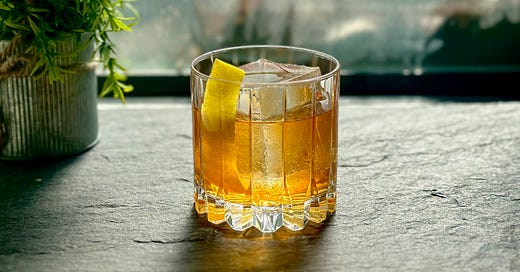The Rusty Nail-Monte Carlo Connection
Bénédictine, Drambuie, and the ultimate basement bar cocktail.
There is no substitute for Bénédictine.
Like Chartreuse, it’s one of a kind, a singular bottle with a unique flavor profile. If you want a Vieux Carré, or a Bobby Burns, or a Monte Carlo — at least one that tastes like it’s supposed to — you need a bottle of Bénédictine. There’s only one true Bénédictine experience.
But while there’s no direct substitute for Bénédictine, there is at least one other bottle that can, at times, play the same role. Once again, the operative metaphor here — one that I have employed many times, and will continue using because it is so apt — is casting, as in actors in the movies.
In Sam Raimi’s 2002 Spider-Man, the main antagonist, Green Goblin, was played by Willem Dafoe. Dafoe excelled in the supervillain role, defining the big-screen version of the character, giving him a kind of growly, grandiose, self-hating pathos. It’s hard to imagine the movie, or the big-screen version of the character, without him.
But it almost wasn’t to be. I recently discovered that Nicolas Cage was offered the Green Goblin part.
And you know what? If you play back the movie in your head, you can, in fact imagine it with Cage instead of Dafoe. Counterfactuals are always tricky, but Cage almost certainly would have played the part quite differently, emphasizing the character’s manic psychology and quirky cartoon physicality. It would have been a very different take on the character, and, even holding everything else equal, a rather different movie. But in its own way, it would have worked.
There’s obviously no substitute for Nicolas Cage. There’s only one true Nicolas Cage experience.
Yet in some circumstances,1 it’s possible to swap Cage with Willem Dafoe and produce something that, while not the same, works on its own terms.
The two actors have some obvious overlapping qualities — a larger-than-life intensity, an ability to deliver empathetic portrayals of characters that are either unpleasant or cartoonishly absurd, a gift for chewing scenery without coming across as unintentionally ridiculous. And thus they can play some of the same roles, albeit in distinctly different fashion.
The same goes for Bénédictine and its honey-spiced spiritual cousin Drambuie.
The two liqueurs represent the cocktail equivalent of a Cage/Dafoe situation. They are not directly substitutable. They do not taste the same. But they have some shared qualities that allow them to play the same parts in drinks. And both of them are at their best as warming, spiced-liqueur sweeteners in simple Old Fashioned-style drinks that pair them with whiskey.
In the case of Bénédictine, as I have argued in the past, the baseline drink is the Monte Carlo.
In the case of Drambuie, that drink is one of the great old man basement bar cocktails from the midcentury era — and one of the easiest Scotch whiskey cocktails to make at home — the Rusty Nail.
So today, we’re going to look at the connection between Bénédictine and Drambuie, the relationship between the Monte Carlo and the Rusty Nail, and the best way to make a modern version of the simple, boozy Scotch whisky comfort drink.
Nailed It!
The main properties you need to understand about both Bénédictine and Drambuie is that they are both…



